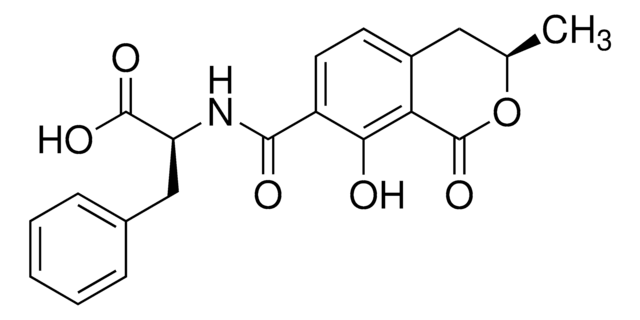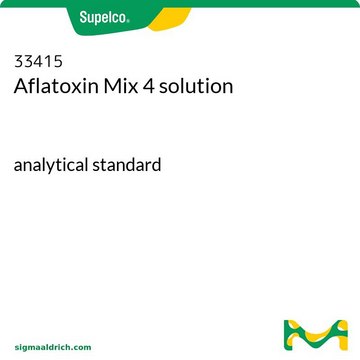CRM46912
Ochratoxine A solution
certified reference material, 50 μg/mL in benzene: acetic acid (99:1), ampule of 1 mL
About This Item
Produits recommandés
Qualité
certified reference material
TraceCERT®
Gamme de produits
TraceCERT®
CofA (certificat d'analyse)
current certificate can be downloaded
Conditionnement
ampule of 1 mL
Concentration
50 μg/mL in benzene: acetic acid (99:1)
Technique(s)
HPLC: suitable
gas chromatography (GC): suitable
Application(s)
cleaning products
cosmetics
food and beverages
personal care
Format
single component solution
Température de stockage
-10 to -25°C
Chaîne SMILES
C[C@@H]1Cc2c(Cl)cc(c(O)c2C(=O)O1)C(=O)N[C@@H](Cc3ccccc3)C(O)=O
InChI
1S/C20H18ClNO6/c1-10-7-12-14(21)9-13(17(23)16(12)20(27)28-10)18(24)22-15(19(25)26)8-11-5-3-2-4-6-11/h2-6,9-10,15,23H,7-8H2,1H3,(H,22,24)(H,25,26)/t10-,15+/m1/s1
Clé InChI
RWQKHEORZBHNRI-BMIGLBTASA-N
Vous recherchez des produits similaires ? Visite Guide de comparaison des produits
Description générale
Ochratoxin A, a mycotoxin, is a naturally occurring secondary metabolite, produced by filamentous fungi, such as Aspergillus and Penicillium. It has been classified as a group 2B substance by International Agency for Research on Cancer, for possibly being carcinogenic to humans.
Application
- Identification and determination of ochratoxin A in different types of commercial coffee samples using dispersive liquid-liquid microextraction-solidification of a floating organic drop (DLLME-SFO) for sample treatment and ultra high-performance liquid chromatography-positive electrospray ionization-tandem mass spectrometry (UHPLC-(+-ESI)-MS/MS)
- Determination of ochratoxin A in beer samples by a selective method based on salting-out assisted liquid-liquid extraction (SALLE) and ultra high-performance liquid chromatography-tandem mass spectrometry (UHPLC-MS/MS)
- Simultaneous determination of ochratoxin A and ochratoxin B in Tokaj wine samples using online solid phase extraction (SPE) combined with high-performance liquid chromatography-fluorescence detection(HPLC-FD)
- Development of an online-SPE-HPLC method to determine ochratoxin A in wine samples
- Electrochemical determination of ochratoxin A using an aptamer-based on functionalized graphene (f-graphene) doped chitosan in grape juice samples by differential pulse voltammetry
Autres remarques
Informations légales
Mention d'avertissement
Danger
Mentions de danger
Conseils de prudence
Classification des risques
Aquatic Chronic 3 - Asp. Tox. 1 - Carc. 1A - Eye Irrit. 2 - Flam. Liq. 2 - Muta. 1B - Skin Irrit. 2 - STOT RE 1
Organes cibles
Blood
Code de la classe de stockage
3 - Flammable liquids
Classe de danger pour l'eau (WGK)
WGK 3
Point d'éclair (°F)
12.2 °F - closed cup
Point d'éclair (°C)
-11 °C - closed cup
Faites votre choix parmi les versions les plus récentes :
Déjà en possession de ce produit ?
Retrouvez la documentation relative aux produits que vous avez récemment achetés dans la Bibliothèque de documents.
Articles
The cannabinoids found in the Cannabis plant commonly referred to as marijuana, have grown in popularity for treating a variety of ailments from arthritis, glaucoma, and chronic pain to malnutrition, multiple sclerosis, and cancer.
Notre équipe de scientifiques dispose d'une expérience dans tous les secteurs de la recherche, notamment en sciences de la vie, science des matériaux, synthèse chimique, chromatographie, analyse et dans de nombreux autres domaines..
Contacter notre Service technique









